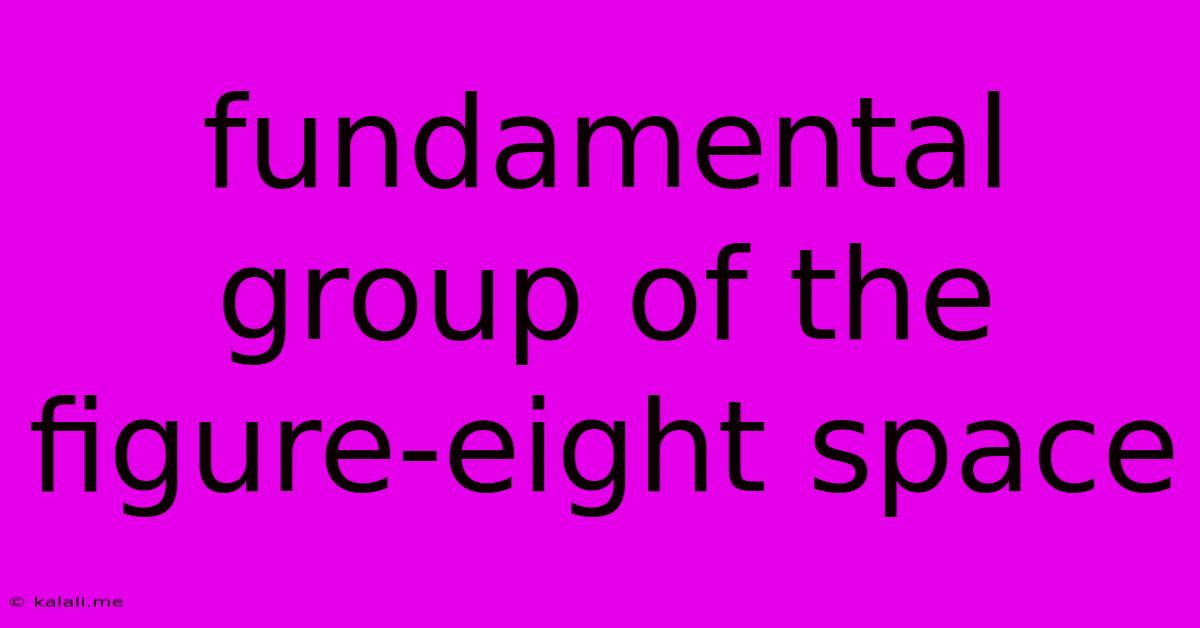Fundamental Group Of The Figure-eight Space
Kalali
May 25, 2025 · 4 min read

Table of Contents
The Fundamental Group of the Figure-Eight Space: A Topological Exploration
The figure-eight space, a seemingly simple topological space, offers a surprisingly rich playground for exploring fundamental groups. This article will delve into understanding its fundamental group, providing a clear explanation accessible to those with a basic understanding of algebraic topology. We'll examine the concept, its calculation, and its significance in understanding the space's topological properties.
The figure-eight space is formed by the union of two circles intersecting at a single point. Its fundamental group, denoted as π₁(X), where X represents the figure-eight space, is non-abelian, making it a fascinating case study contrasting with the fundamental groups of simpler spaces like circles (which are abelian). Understanding this non-abelian nature is key to appreciating the space's topological complexity.
Understanding Fundamental Groups
Before we tackle the figure-eight space specifically, let's quickly review the concept of the fundamental group. The fundamental group of a topological space X based at a point x₀ ∈ X, denoted π₁(X, x₀), classifies the loops in X starting and ending at x₀ up to homotopy equivalence. Intuitively, two loops are homotopic if one can be continuously deformed into the other without lifting the loop off the space. The group operation is concatenation of loops.
Calculating the Fundamental Group of the Figure-Eight Space
The figure-eight space is often represented as the union of two circles, say a and b, intersecting at a single point. To calculate its fundamental group, we utilize the Seifert-van Kampen theorem, a powerful tool in algebraic topology. This theorem allows us to compute the fundamental group of a space by considering the fundamental groups of its simpler constituent parts.
Applying the Seifert-van Kampen Theorem:
The Seifert-van Kampen theorem states that if a space X is the union of open connected subspaces U and V such that U ∩ V is path-connected, then the fundamental group of X is related to the fundamental groups of U, V, and U ∩ V. In the case of the figure-eight, we can consider U and V as neighborhoods of each circle, such that their intersection is a small neighborhood of the intersection point.
-
Fundamental groups of U and V: Each of U and V is homotopy equivalent to a circle, thus their fundamental groups are isomorphic to ℤ (the integers). We can represent the generators of these groups as a and b, corresponding to the loops around each circle.
-
Fundamental group of U ∩ V: The intersection U ∩ V is path-connected and homotopy equivalent to a point. Therefore, its fundamental group is the trivial group {e}.
-
Combining the groups: The Seifert-van Kampen theorem then tells us that the fundamental group of the figure-eight space is the free group on two generators, denoted as F(a, b). This means that π₁(X) consists of all possible words formed by a, b, a⁻¹, and b⁻¹ under concatenation, subject to the relation that ab is not equal to ba. This non-commutativity is crucial; it highlights the non-abelian nature of the fundamental group.
Therefore, the fundamental group of the figure-eight space is the free group on two generators, F(a, b).
Significance and Applications
The non-abelian nature of the fundamental group of the figure-eight space is significant. It indicates a more complex topological structure compared to spaces with abelian fundamental groups. This non-abelian structure reflects the inability to continuously deform loops around one circle into loops around the other without passing through the intersection point. This property finds applications in various areas of mathematics, including:
-
Knot Theory: The fundamental group plays a crucial role in distinguishing different knots.
-
Algebraic Topology: It serves as a powerful invariant for classifying topological spaces.
-
Geometric Group Theory: It provides a connection between algebraic structures and geometric spaces.
In conclusion, while seemingly simple, the figure-eight space provides a valuable example demonstrating the power and importance of fundamental groups in understanding topological spaces. Its non-abelian fundamental group, a free group on two generators, is a testament to the richness and complexity hidden within seemingly straightforward geometrical shapes. This fundamental group offers a key to unlocking a deeper understanding of the space's topological properties and its role in broader mathematical contexts.
Latest Posts
Latest Posts
-
How To Tell If Rotors Are Bad
May 25, 2025
-
What Is The Difference Between Par20 And Par38 Bulbs
May 25, 2025
-
How Fast Can A Helicopter Fly
May 25, 2025
-
What Does The Neutral Wire Do
May 25, 2025
-
How To Get Rid Of Rabbits In Your Yard
May 25, 2025
Related Post
Thank you for visiting our website which covers about Fundamental Group Of The Figure-eight Space . We hope the information provided has been useful to you. Feel free to contact us if you have any questions or need further assistance. See you next time and don't miss to bookmark.